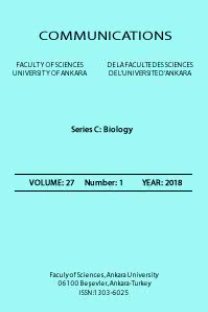COMPARISON OF TOXIC AND ANTITOXIC EFFECTS OF CISPLATIN AND CAMP, AT CYP1A1 GENE EXPRESSION LEVEL OF WISTAR ALBINO TYPE RAT LIVER
cisplatin, cAMP, Wistar albino, cytochrome p450, gene expression, forensic toxicology
___
U. M. Zanger and M. Schwab, Cytochrome P450 enzymes in drug metabolism: regulation of gene expression, enzyme activities, and impact of genetic variation, Pharmacology & Therapeutics, 138 (1), (2013) 103-141.K. Barabas, R. Milner, D. Lurie, and C. Adin, Cisplatin: a review of toxicities and therapeutic applications, Veterinary and Comparative Oncology, 6 (1), (2008) 1-18.
R.P. Miller, R.K. Tadagavadi, G. Ramesh and W.B. Reeves, Mechanisms of cisplatin nephrotoxicity, Toxins, 2 (11), (2010) 2490-2518.
R. Mosenden and K. Tasken, Cyclic AMP-mediated immune regulation—overview of mechanisms of action in T cells, Cellular Signalling, 23 (6), (2011) 1009-1016.
G. Akbal, Sisplatin verilmiş ratlarda cAMP ve CoQ’nun karaciğer radikal süpürücü enzim aktiviteleri üzerine etkilerinin ve hasar giderilmesindeki rollerinin araştırılması, Doktora Tezi, Ondokuz Mayıs Universitesi, Fen Bilimleri Enstitüsü, (2010).
F.J. Gonzalez and H.V. Gelboin, Role of human cytochromes P450 in the metabolic activation of chemical carcinogens and toxins, Drug Metabolism Reviews, 26 (1-2), (1994) 165-183.
V.P. Androutsopoulos, A.M. Tsatsakis and D.A. Spandidos, Cytochrome P450 CYP1A1: wider roles in cancer progression and prevention, BMC Cancer, 9 (1), (2009) 187.187.
H. Liu, L. Shi, J.P. Giesy and H. Yu, Polychlorinated diphenyl sulfides can induce ROS and genotoxicity via the AhR-CYP1A1 pathway, Chemosphere, 223, (2019) 165-170.
S. Winslow, A. Scholz, P. Rappl, T.F. Brauß, C. Mertens, M. Jung and T. Schmid, Macrophages attenuate the transcription of CYP1A1 in breast tumor cells and enhance their proliferation, Plos One, 14 (1), (2019) e0209694.
J. P. Wu, L. W. Chang, H. T. Yao, H. Chang, H. T. Tsai, M. H.Tsai and P. Lin, Involvement of oxidative stress and activation of aryl hydrocarbon receptor in elevation of CYP1A1 expression and activity in lung cells and tissues by arsenic: an in vitro and in vivo study, Toxicological sciences, 107 (2), (2008) 385-393.
L. Han, L. Li, G.J. Muehlbauer, J.E. Fowler and M M. Evans, RNA Isolation and analysis of LncRNAs from gametophytes of maize, In Plant Long Non-Coding RNAs (pp. 67-86), Humana Press, New York, (2019).
F.J. Gonzalez, The molecular biology of cytochrome P450s, Pharmacological Reviews, 40 (4), (1988) 243-288.
X. Ding and L.S. Kaminsky, Human extrahepatic cytochromes P450: function in xenobiotic metabolism and tissue-selective chemical toxicity in the respiratory and gastrointestinal tracts, Annual Review of Pharmacology and Toxicology, 43 (1), (2003) 149-173.
S.A.Wrighton, M.VandenBranden and B.J. Ring, The human drug metabolizing cytochromes P450, Journal of Pharmacokinetics and Biopharmaceutics, 24 (5), (1996) 461-473.
M.E. McManus, I. Stupans, B. Ioannoni, W. Burgess, R.A. Robson and D.J. Birkett, Identification and quantitation in human liver of cytochromes P-450 analogous to rabbit cytochromes P-450 forms 4 and 6, Xenobiotica, 18 (2), (1988) 207-216.
D.J. Adams, S. Seilman, Z. Amelizad, F. Oesch and C.R. Wolf, Identification of human cytochromes P-450 analogous to forms induced by phenobarbital and 3-methylcholanthrene in the rat, Biochemical Journal, 232 (3), (1985) 869-876.
S.A. Wrighton, C. Campanile, P.E. Thomas, S.L. Maines, P.B. Watkins, G. Parker and W. Levin et al., Identification of a human liver cytochrome P-450 homologous to the major isosafrole-inducible cytochrome P-450 in the rat. Molecular Pharmacology, 29 (4), (1986) 405-410.
H. Schweikl, J.A. Taylor, S. Kitareewan, P. Linko, D. Nagorney and J.A. Goldstein, Expression of CYP1A1 and CYP1A2 genes in human liver. Pharmacogenetics, 3 (5), (1993) 239-249.
F.P. Guengerich, Mechanisms of cytochrome P450 substrate oxidation: MiniReview, Journal of Biochemical and Molecular Toxicology, 21(4), (2007) 163-168.
- ISSN: 1303-6025
- Yayın Aralığı: Yılda 2 Sayı
- Başlangıç: 1943
- Yayıncı: Ankara Üniversitesi
METAL ACCUMULATION PROFILE IN CRAYFISH TISSUES FROM ÇOMAR STREAM
Seyda FIKIRDESICI-ERGEN, Hatice MUTLU-EYISON, Ahmet ALTINDAG
THREAT CATEGORIES OF ENDEMIC PLANTS OF SAKARAT MOUNTAIN (AMASYA/TURKEY)
M. Umit BINGOL, Neslihan BALPINAR, Kerim GUNEY, Arzu CANSARAN, Fatmagul GEVEN, Omer Faruk KAYA, Munevver ARSLAN
THE PALYNOLOGICAL TRAITS OF FOUR ENDEMIC SILENE L. (CARYOPHYLLACEAE) SPECIES IN TURKEY
Burcu Yilmaz CITAK, Huseyin DURAL
HISTOMORPHOLOGICAL CHANGES ON THE TESTICULAR TISSUE IN DIABETIC RATS INDUCED WITH STREPTOZOTOCIN
Nihal SAÇMAOZU, Hatice MUTLU EYISON, Suna CEBESOY
GENERAL OVERVIEW OF THE STUDIES WITH MALDI-TOF
İlker BUYUK, Behcet INAL, Emre ILHAN, Sumer ARAS
CHEMOTAXONOMY IN BACTERIAL SYSTEMATICS
Kumbirai Deon MANDEBERE, F. Seyma GOKDEMIR, Gonul SOLMAZ, Sumer ARAS
FOUR NEW MICROFUNGI FOR TURKISH ASCOMYCOTA
Sanli KABAKTEPE, İlgaz AKATA, Mustafa SEVINDIK
EVALUATION OF THREAT CATEGORIES OF THE ENDEMIC PLANTS OF DEVECI MOUNTAINS (YOZGAT-TOKAT/TURKEY)
M. Umit BINGOL, Neslihan BALPINAR, Kerim GUNEY, Fatmagul GEVEN, Osman KETENOGLU, Munevver ARSLAN, Mehmet KARAKAS
